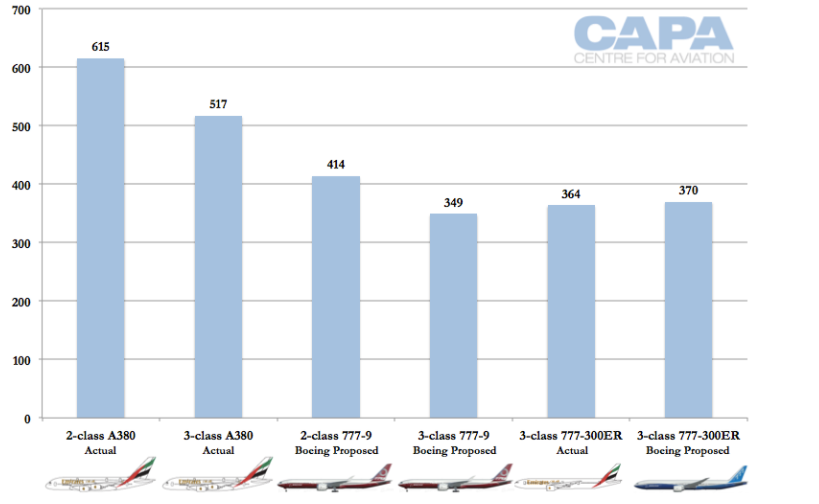An insights analysis from CAPA - Centre for Aviation titled Emirates' options on an A380 replacement are complex. Use 777s, cut capacity, grow frequencies? suggests that Emirates may need to make some important decisions on many of its routes out of its Dubai International Airport hub, either cutting capacity in markets or growing flight frequencies.
"Most airlines use their small A380 fleet as a showpiece flying a handful of flights," says the CAPA report. "For Emirates the A380 is a workhorse, reaching 47 airports with 172 daily flights."
TABLE - Emirates Airline operates the largest fleet of Airbus A380s and is likely to use the 777-9 as a replacement Source: CAPA - Centre for Aviation fleet database
Source: CAPA - Centre for Aviation fleet database
According to the CAPA fleet database, Emirates currently operates a fleet of 96 A380s with a further 46 on order. The earliest examples have been flying with the airline since July 2008 and is now reaching ten years of age and while some of its order backlog will replace some of its early deliveries towards the end of this decade and during the start of the 2020s, a number of A380s will need to be replaced in the 2020s.
CHART - There is a significant capacity difference between the A380 and Emirates' current 777-300ER Source: CAPA - Centre for Aviation
Source: CAPA - Centre for Aviation
There is currently a major capacity difference between the A380 and the next largest aircraft in the Emirates fleet, the 777-300ER. The airline has 115 777-9s on order and these are likely to seat up to 390 passengers in a three-class and 414 in a two-class arrangement based on the current configuration used on the 777-300ER, which is approximately two metres shorter in length.
"If Emirates adapts its 777-300ER LOPA to the 777-9, it could look to seat approximately 390 passengers, but this would still represent a 25% cut compared to the A380. If Emirates were to replace the A380 with 777-9s but wanted to maintain a more premium product, its 777-9s (or rather a sub-fleet) would have to seat fewer passengers, for which Boeing's proposed LOPA of 349 is indicative - but means a 32% decrease in seats," says the CAPA report.
CHART - Emirates is likely to seat between 349 and 414 passengers on its 777-9 Source: CAPA - Centre for Aviation
Source: CAPA - Centre for Aviation
This capacity shortfall is what creates the future operational headache for Emirates. As the CAPA report highlights, if Emirates wants to maintain its 2017 seat capacity in Europe but only with 777-9s, it would need to add at least 10 daily flights. Similarly, in East Asia, the airline would need to add three daily flights, in North America it would need to add one daily flight, while for Australia and New Zealand Emirates would need to add two to three daily flights.
One city pair market which illustrates the capacity dilemma at its strongest is the Dubai - London Heathrow route, a market that the A380 was perfectly designed to serve due to the restricted slot availability at the UK gateway. The CAPA report suggests Emirates would have to replace its six daily A380 rotations with eight 777-9s flights, but gaining those additional slots at Heathrow would come at a significant expense. Similarly, there would be a need to accommodate more flights out of Dubai, whether from Dubai International or Dubai World Central Al Maktoum if Emirates has made its move by that time.
Read the full CAPA - Centre for Aviation insights analysis on Emirates' Airbus A380 replacement dilemma: Emirates' options on an A380 replacement are complex. Use 777s, cut capacity, grow frequencies?